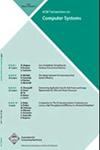PowerNap服务器架构
IF 2
4区 计算机科学
Q2 COMPUTER SCIENCE, THEORY & METHODS
引用次数: 43
摘要
数据中心的电力消耗正增长到前所未有的水平:美国环保署估计,到2011年,美国数据中心每年将消耗1000亿千瓦时。大部分的能量都浪费在空闲系统上:在典型的部署中,服务器利用率低于30%,但是空闲服务器仍然消耗其峰值功耗的60%。典型的空闲时间(虽然频繁)持续几秒钟或更短,使简单的节能方法变得混乱。在本文中,我们提出了PowerNap,这是一种节能方法,整个系统在响应瞬时负载时在高性能主动状态和接近零功耗空闲状态之间快速转换。PowerNap不需要单个系统组件的细粒度功率性能状态和复杂的负载比例操作,而是要求最小化空闲功率和转换时间,这是更简单的优化目标。基于PowerNap概念,我们开发了需求并概述了消除企业刀片服务器中空闲电源浪费的机制。由于PowerNap在当前刀片中心电源的低效率区域运行,因此我们引入了廉价负载共享冗余阵列(RAILS),这是一种电源供应方法,可在PowerNap的整个功率需求范围内提供高转换效率。通过使用从企业级商业部署中收集的利用率跟踪,我们证明,PowerNap和RAILS一起可以将服务器的平均功耗降低74%。本文章由计算机程序翻译,如有差异,请以英文原文为准。
The PowerNap Server Architecture
Data center power consumption is growing to unprecedented levels: the EPA estimates U.S. data centers will consume 100 billion kilowatt hours annually by 2011. Much of this energy is wasted in idle systems: in typical deployments, server utilization is below 30%, but idle servers still consume 60% of their peak power draw. Typical idle periods---though frequent---last seconds or less, confounding simple energy-conservation approaches.
In this article, we propose PowerNap, an energy-conservation approach where the entire system transitions rapidly between a high-performance active state and a near-zero-power idle state in response to instantaneous load. Rather than requiring fine-grained power-performance states and complex load-proportional operation from individual system components, PowerNap instead calls for minimizing idle power and transition time, which are simpler optimization goals. Based on the PowerNap concept, we develop requirements and outline mechanisms to eliminate idle power waste in enterprise blade servers. Because PowerNap operates in low-efficiency regions of current blade center power supplies, we introduce the Redundant Array for Inexpensive Load Sharing (RAILS), a power provisioning approach that provides high conversion efficiency across the entire range of PowerNap’s power demands. Using utilization traces collected from enterprise-scale commercial deployments, we demonstrate that, together, PowerNap and RAILS reduce average server power consumption by 74%.
求助全文
通过发布文献求助,成功后即可免费获取论文全文。
去求助
来源期刊

ACM Transactions on Computer Systems
工程技术-计算机:理论方法
CiteScore
4.00
自引率
0.00%
发文量
7
审稿时长
1 months
期刊介绍:
ACM Transactions on Computer Systems (TOCS) presents research and development results on the design, implementation, analysis, evaluation, and use of computer systems and systems software. The term "computer systems" is interpreted broadly and includes operating systems, systems architecture and hardware, distributed systems, optimizing compilers, and the interaction between systems and computer networks. Articles appearing in TOCS will tend either to present new techniques and concepts, or to report on experiences and experiments with actual systems. Insights useful to system designers, builders, and users will be emphasized.
TOCS publishes research and technical papers, both short and long. It includes technical correspondence to permit commentary on technical topics and on previously published papers.
 求助内容:
求助内容: 应助结果提醒方式:
应助结果提醒方式:


